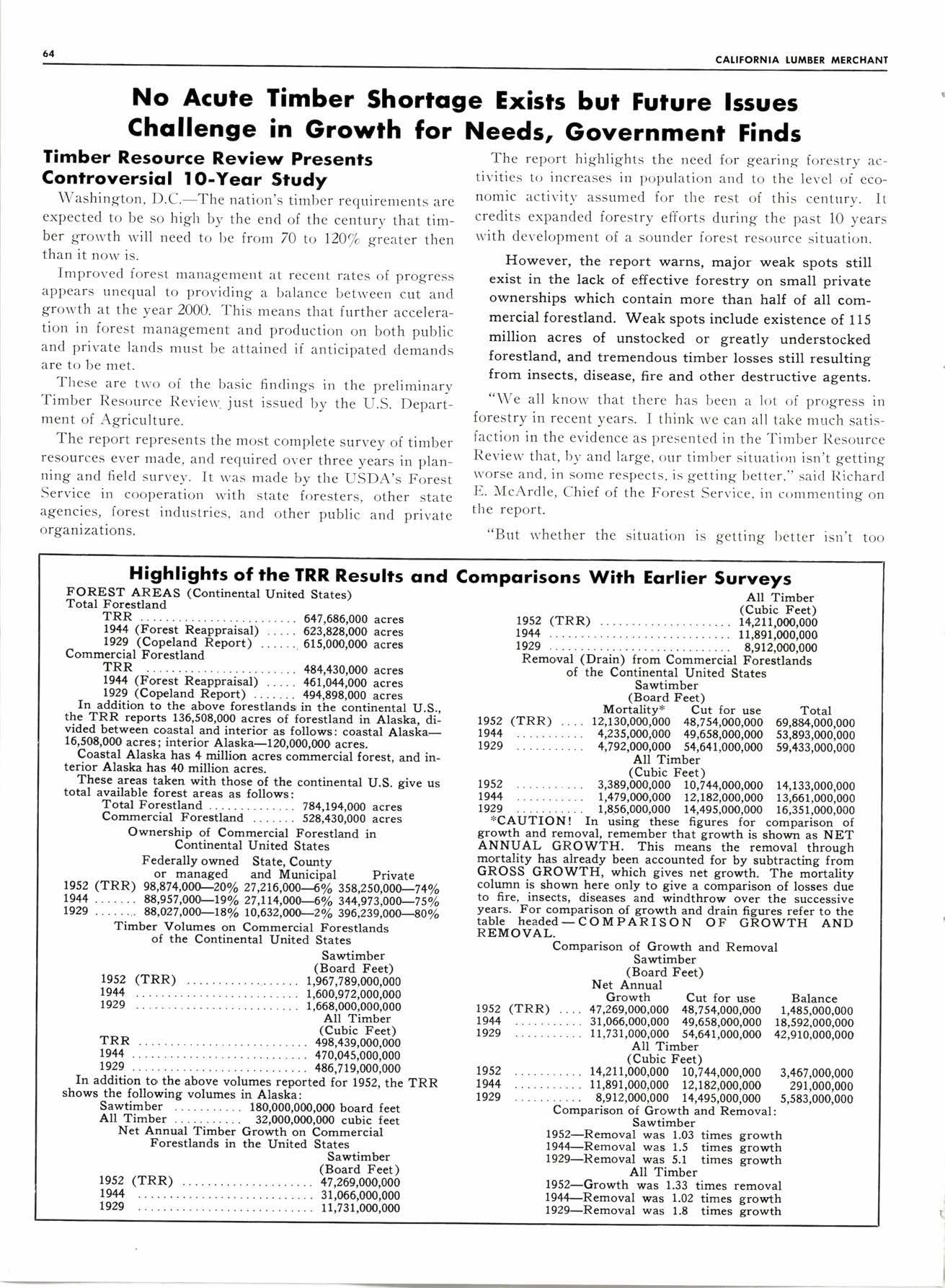
2 minute read
No Acute Timber Shortoge Exists bur Future lssues Chollenge in Growth for Needs, Government Finds
fimber R,esource Review Presents Confroversiql I O-Yeor Study
Washington, D.C.-The nation's timber requirenrents are expected to be so high by the end of the century that timber growth will need to be from 70 to IZO% greater then than it now is.
Improved forest management at recetlt rates of progress appears unequal to providing a balance betrveen cut and growth at the year 2000. This means that further acceleration in forest management and production on both public and private lands must be attained if anticipated demands are to be met.
Tl.rese are tu'o of the basic findings in the preliminary Timber Resource Revieu' just issued by the U.S. Department of Agriculture.
The report represents the most complete survey of timber resources ever made, and required over three years in plan_ ning and field survey. It was made by the USDA's Forest Service in cooperation with state foresters, other state agencies, forest industries, and other public and private organizations.
Highlighfs of rhe TRR Resulrs crnd
The report highlights the need for gearing forestry activities to increases in population and to the level of economic activity assumed for the rest of this century. It credits expanded forestry efforts during the past 10 years with development of a sounder forest resource situation.
Ilowever, the report warns, major weak spots still exist in the lack of e.ffective forestry on small private ownerships which contain more than half of all commercial forestland. Weak spots include existence of 11S million acres of unstocked or greatly understocked forestland, and tremendous timber losses still resulting from insects, disease, fire and other destructive agents.
"Weall know that there has been a lot of progress in forestry in recent years. I think we can all take much satisfaction in the evidence as presented in the Timber llesource Review that, by and large, our timber situation isn't getting worse and, in some respects, is getting better," said l{ichard E. McArdle, Chief of the Forest Service, in commenting on the report.
"But whether the situation is getting ltetter isn't too
Comporisons Wirh Ecrrlier Surveys
(rRR) f8tii:r$:tr} acres acres
In addition to the above forestlands in the continental U.S., tlg TBR reports 136,508,dn acres of forestland in Alaska, dii vided between coastal and interior as follows: coastal Ahs(a- 16,508,000 ac-res ; interior AhskJtzO,OOO,mO ""i".. Coastal Alaska has 4 millio,n acres comrnercial forest, and interior Alaska has 40 million acres.
These areas taken with those of the continental U.S. give us total available forest areas as follows:
Ownership of Commercial Forestland in Co,ntinental United States
Federally owned State, County or managed and Municipal private
I 952 (TRR ) 98,87 4,0W20% 27,216,0004% 358,2 iO,OOc-il4/o \?y 88,957,00L19yo 27,114,W6o/o 344,,973,000-756/o
1929 .,. 8,u27,00r'8yo to,6g2,Wzit/o 396:n9',o0o-80i,/o
Timbcr Volumes on Commercial Forestlands of the Continental United States
Sawtimber res2 (rRR) .... t,I?i,%t,ffii3lo
1944 .. . l,6oa,972,ooo,ooo reze .. .. . t,u68,1T,.r3,000 rRR . -!"rf;",rtrB,
.. 470,045,000:000 1929 .. .....486,7t9,000;Ooo
In addition to the above volumes reported f,or l9SZ, the TRR shows the following volumes in Alaskl: Sawtimber .... 180,000,000,000boardfeet
All Timber 32,000,00O,0(n cubic feet
Net Annual Timber Growth on Commercial Forestlands in the United States
*CAUTIONI In using these figures for comparison of growtll and removal, remember that growth is shown as NET ANNUAL GROWTH. This means the removal through mortaliJylas^Clt34y been accounted for by subtracting froin GROSS GROWTH, which gives net growth. The mdrtality column is shown here only to give a comparison of losses dul to fire, insects, diseases and windthrow over the successive yga_rs. For comparison of growth and drain figures refer to the table headed-COMPARISON OF GROWTH
Comparison of Growth and Removal l9rS4-Removal was 1.5 times growth
1929-Removal was 5.1 times growth All Timber
1952-Growth was 1.33 times removal 1944-Removal was 1.02 times growth 1929-Removal was 1.8 times growth










